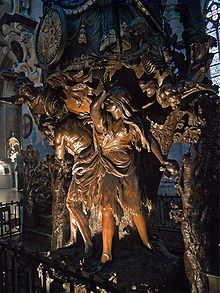Forbidden fruit
The words forbidden fruit stand as a metaphor (an image). The metaphor comes from the book of Genesis in the Bible. There Adam and Eve are thrown out of Paradise because they eat from the tree of knowledge.[1]

The fruit has commonly been represented as an apple due to wordplay of the Latin word for apple, malus, which can mean both "evil" and "apple". The Bible does not specify a fruit, but locates it as being at the very center of The Garden of Eden. In Judaism the fruit is believed to be either a grape, a fig, a citron or wheat. Most scholars say that the type of fruit is not forbidden, it was just the fruits of that particular tree that were.
In general, the term can also refer to something illegal or immoral to do. It might also be dangerous. Many times this is about sex outside of marriage.
Gnostic scriptures consider the forbidden fruit as something positive and the act to make it forbidden as a malevolent action from humanity's creators.[2]
Related pages
changeReferences
change- ↑ Old Testament, Genesis 1:16-17, "And the Lord God commanded the man, saying, Of every tree of the garden thou mayest freely eat: But of the tree of the knowledge of good and evil, thou shalt not eat of it: for in the day that thou eatest thereof thou shalt surely die."
- ↑ Rossbach, Stefan (August 7, 2019) [1999]. Gnostic Wars. Edinburgh University Press. p. 51. ISBN 9781474472180.